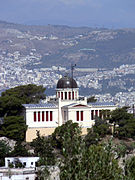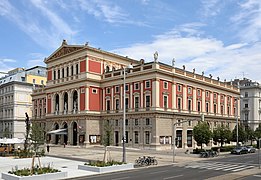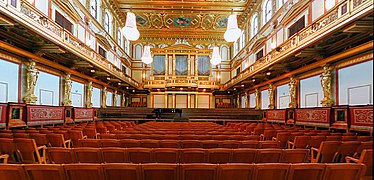Theophil Hansen


Baron Theophil Edvard von Hansen(German:[ˈteːofiːlfɔnˈhanzn̩];original Danish name:Theophilus Hansen,pronounced[tsʰe̝oˈfiːlusˈhænˀsn̩];13 July 1813 – 17 February 1891) was a Danish architect who later became an Austrian citizen. He became particularly well known for his buildings and structures in Athens and Vienna, and is considered an outstanding representative ofNeoclassicismandHistoricism.[1]
Biography
[edit]Hansen was born inCopenhagen.After training with Prussian architectKarl Friedrich Schinkeland some years studying in Vienna, he moved toAthensin 1837, where he studied architecture and design, with a concentration and interest inByzantine architecture.During his stay in Athens, Hansen designed his first building, theNational Observatory of Athensand two of the three contiguous buildings forming the so-called "Athenian Trilogy": theAcademy of Athensand the National Library of Greece, the third building of the trilogy being theNational and Capodistrian University of Athens,which was designed by his brotherHans Christian Hansen(1803–1883).[2] [3][4]
The Greek-Austrian entrepreneurGeorgios Sinas(1783–1856), who donated the observatory, called Hansen to Vienna in 1846, where Hansen took up an apprenticeship with noted Austrian architectLudwig Förster(1797–1863). In his early works, such as the museum in theVienna Arsenal,Hansen was still rather aligned to a more romantic style. In later years, he became the most outstanding representative of Renaissance-inspired historicism (Neo-Renaissance), which also came to be known as Viennese-style. This style extended into the smallest details of the interior design and partially accepted the courses of a synthesis of the arts.[5]
Along with Förster and many others, Hansen was one of the most important and influential architects of the VienneseRingstraße.His most famous work is theAustrian Parliament building,which was created in the style of an ancient, neo-classic temple, and serves to refer to the Greek beginnings ofdemocracy.Hansen was originally a staunch critic of the Classical style that was taught to him at the Copenhagen Academy. Over the years, however, he came to incorporate Classical elements into his forms.Bauleiteron this project was Swiss-Austrian architectHans Auer(1847–1906) who would go on to win the competition for the SwissBundeshaus.[6]
Hansen's famedMusikvereinin Vienna is one of the most notable concert halls in the world; a concert hall whose design and acoustics are often admired and copied in present-day music houses.[7]

Hansen worked together with Austrian sculptor Vincenz Pilz (1816–1896) and artistCarl Rahl(1812–1865), as well as with architectOtto Wagner(1841–1918).[8][9][10]
In 1884 EmperorFranz Josephhonoured Hansen with abaronyin the Austrian nobility and he was since styled "Freiherrvon Hansen ".[11][12]
He died in 1891 in Vienna.
Work
[edit]- National Observatory of Athens,1842
- House of military invalids,Lviv,1851–1863
- Academy of Athens,Athens, starting from 1856
- Museum of Military Historyin theVienna Arsenal,1856
- Old Municipal Hospital inPatras,Greece, 1857
- Cemetery chapel Christuskirche at theMatzleinsdorf Protestant Cemetery,Vienna, 1858
- Holy Trinity Greek Orthodox Church, Vienna,1858–1861
- Palais Todesco,Ringstrasse, Vienna, 1861–1864
- Palace of Archduke Wilhelm,Vienna, 1864–1868
- Musikverein,Vienna, 1867–1870
- Academy of Fine Arts Vienna,1871–1876
- Philharmonic Concert Hall,Brno,1871–1873
- Vienna Stock Exchange,1874–1877
- Austrian Parliament Building,Vienna, 1874–1883
- Zappeion,Athens, 1874–1888
- New Lutheran church,Kežmarok,1879–1892
- Castle Nadelburg,Lichtenwörth,Lower Austria 1880–1882
- National Library of Greece,Athens, starting from 1888
Gallery
[edit]-
Athens Observatorium
-
Academy of Athenspart of the 'Athenian Trilogy' in Athens
-
Musikvereinbuilding in Vienna
-
Goldener Saalin theMusikvereinsgebäudein Vienna
-
TheZappeion Megaronin Athens
-
Castle Nadelburgin Lichtenwörth, Lower Austria
-
Reichsratin Vienna, today theAustrian Parliament Building
-
Palais Hansenin Vienna
-
National Library of Greece
-
New Lutheran churchinKežmarok
References
[edit]- ^"Theophilus Edvard Hansen, 1813–91, Arkitekt".Dansk biografisk Lexikon.Retrieved1 May2019.
- ^"Karl Friedrich Schinkel (1781–1841)".architectural-review. 27 November 2017.Retrieved1 May2019.
- ^Ida Haugsted."Christian Hansen".Den Store Danske, Gyldendal.Retrieved1 May2019.
- ^"Athenian Trilogy".greece-is.17 December 2015.Retrieved1 November2019.
- ^"Ludwig von Förster".Deutsche Digitale Bibliothek.Retrieved1 May2019.
- ^"Hans Auer".Bibliographie der Schweizergeschichte.Retrieved1 May2019.
- ^"Musikverein".Planet-Vienna.Retrieved1 May2019.
- ^"Vincenz Pilz (1816–1896)".Biographisches Lexikon des Kaiserthums Oesterreich.Retrieved1 May2019.
- ^"Rahl, Karl".Allgemeine Deutsche Biographie.1888. p. 167.Retrieved1 May2019.
- ^"Otto Wagner, 1841–1918".ottowagner.Retrieved1 May2019.
- ^"Pilz, Vincenz".Nordisk familjebok.Retrieved1 November2019.
- ^"Karl Rahl".gedaechtnisdeslandes.at.Retrieved1 November2019.
Further reading
[edit]- Robert Bachtrögl:Die Nadelburg – Geschichte ab 1747.2010 (Theophil Hansen starting at p. 77)
- R[ichard] Kurdiovsky (30 November 2015) [1958]."Hansen, Theophil (Theophilos) Freiherr von (1813–1891), Architekt".Österreichisches Biographisches Lexikon ab 1815(online) (in German). Vol. 2.Austrian Academy of Sciences.pp. 181–182.
- Manfred Leithe-Jasper: "Hansen, Theophilos Edvard Freiherr von".In:Neue Deutsche Biographie(NDB). Vol. 7, Duncker & Humblot, Berlin 1966,ISBN3-428-00188-5,pp. 634 f.
- Julius Leisching: "Hansen, Theophilos Edvard Freiherr von".In:Allgemeine Deutsche Biographie(ADB). Vol. 49, Duncker & Humblot, Leipzig 1904, pp. 762–766.
- George Niemann(ed.), Ferdinand von Feldegg:Theophilus Hansen und seine Werke.A. Schroll & Co., Wien 1893.
- Andreas P. Pittler,Hermann Schnell:Der Baumeister des Parliaments – Theophil Hansen (1813–1891).Edition Winkler-Hermaden, Vienna 2013,ISBN978-3950361100
- Adolf Stiller (ed).:Theophil Hansen – Klassische Eleganz im Alltag.Müry Salzmann, Salzburg / Vienna 2013,ISBN978-3-990140-76-5.
- Alice Strobl: "Das k. k. Waffenmuseum im Arsenal. Der Bau und seine künstlerische Ausschmückung", in:Schriften des Heeresgeschichtlichen Museums in Wien,published by the museum. Graz / Cologne, 1961
- Renate Wagner-Rieger and Mara Reissberger (1980)Theophil von Hansen.(Series: Die Wiener Ringstraße VIII; vol. 4) Wiesbaden: SteinerISBN3-515-02676-2
External links
[edit] Media related toTheophil Hansenat Wikimedia Commons
Media related toTheophil Hansenat Wikimedia Commons
- 1813 births
- 1891 deaths
- Austrian barons
- Austrian people of Danish descent
- Danish expatriates in Austria
- Danish neoclassical architects
- Burials at the Vienna Central Cemetery
- Architects from Copenhagen
- Recipients of the Royal Gold Medal
- People associated with the Academy of Fine Arts Vienna
- Theophil Hansen buildings
- Architecture of Athens
- 19th-century Danish architects










